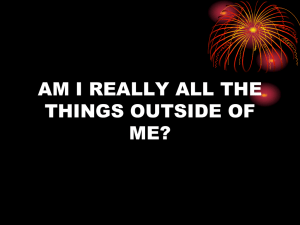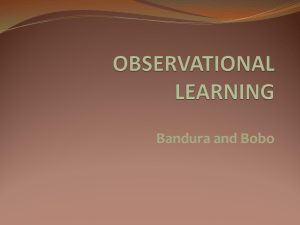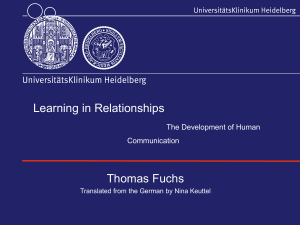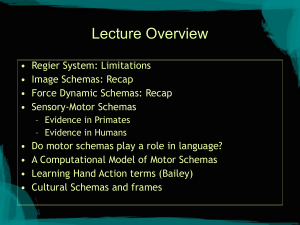Mirror Neurons and the Self
advertisement
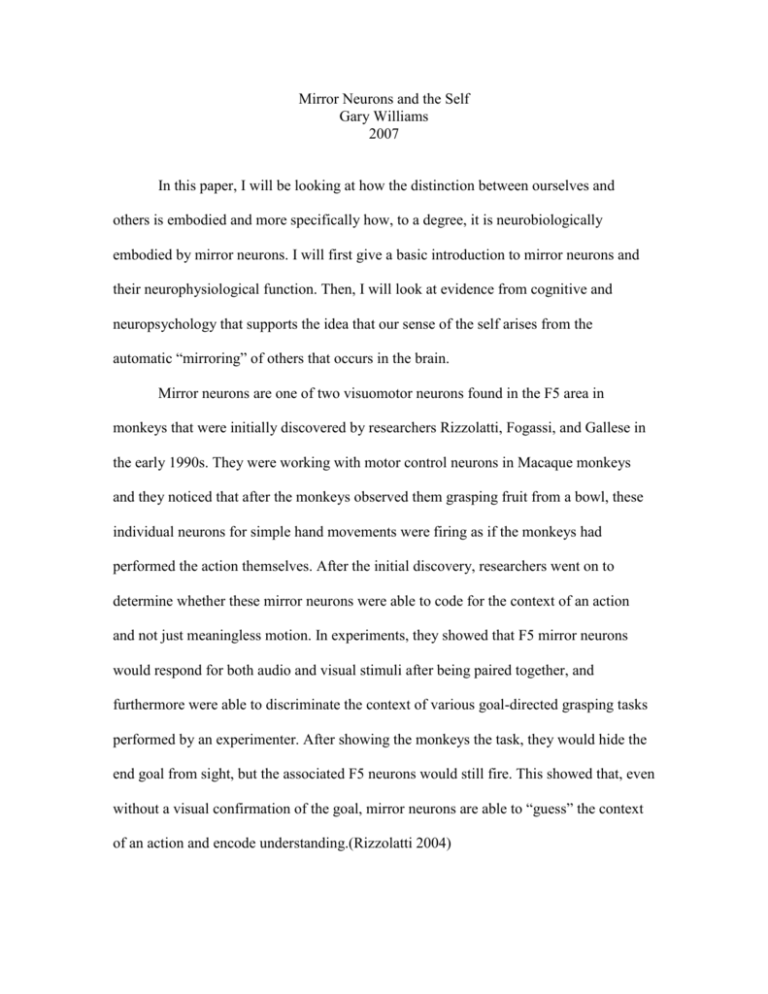
Mirror Neurons and the Self Gary Williams 2007 In this paper, I will be looking at how the distinction between ourselves and others is embodied and more specifically how, to a degree, it is neurobiologically embodied by mirror neurons. I will first give a basic introduction to mirror neurons and their neurophysiological function. Then, I will look at evidence from cognitive and neuropsychology that supports the idea that our sense of the self arises from the automatic “mirroring” of others that occurs in the brain. Mirror neurons are one of two visuomotor neurons found in the F5 area in monkeys that were initially discovered by researchers Rizzolatti, Fogassi, and Gallese in the early 1990s. They were working with motor control neurons in Macaque monkeys and they noticed that after the monkeys observed them grasping fruit from a bowl, these individual neurons for simple hand movements were firing as if the monkeys had performed the action themselves. After the initial discovery, researchers went on to determine whether these mirror neurons were able to code for the context of an action and not just meaningless motion. In experiments, they showed that F5 mirror neurons would respond for both audio and visual stimuli after being paired together, and furthermore were able to discriminate the context of various goal-directed grasping tasks performed by an experimenter. After showing the monkeys the task, they would hide the end goal from sight, but the associated F5 neurons would still fire. This showed that, even without a visual confirmation of the goal, mirror neurons are able to “guess” the context of an action and encode understanding.(Rizzolatti 2004) The breakthrough discovery of these mirror neurons in monkeys sparked the search for an analogous neural mechanism in humans. This posed to be a problem for researchers, due to the inaccurate spatial resolution of brain imaging for locating anything close in size to the mirror neurons found with single-cell techniques for monkeys. While the direct approach is still impractical, the indirect method, using EEG (electroencephalogram), MEG (magnetoencephalography), TMS(transcranial magnetic stimulation), and fMRI(functional magnetic resonance imaging) imaging techniques, has made startling advances in unraveling the complex mirror neuron system(MNS) in humans. The first confirmation came from EEG and MEG studies showing a desynchronization of mu-rhythms during an action and when the subjects observed someone perform the same action (Cochin et al.1998). More substantial evidence for the MNS in humans has come from TMS studies measuring motor-evoked potentials during both goal and non-goal oriented hand tasks. Further studies with TMS demonstrated several important properties in the human MNS, including sensitivity to temporal phases of an action, suggesting that, unlike mirror neurons in monkeys, human mirroring codes for the formation of actions, and not just the end goal action. A host of recent studies has suggested the human MNS is located primarily in the occipital, temporal, and parietal areas and also the rostral part of the inferior parietal lobule, the lower part of the precentral gyrus, and the posterior part of the inferior frontal gyrus (Rizzolatti et al, 2004). This automatic understanding of action underlies my thesis that the distinction between the self and other stems from an embodied, unconscious mechanism that arises from “simulated” motor schema of other agents. When I see another person pick up an apple and move it towards their face, my own motor programs are unconsciously activated for the same intentional action. It is this activation of the appropriate motor schemas that gives structure to our phenomenal experience and makes the categorization of self and other a natural, automatic process. It is important to note that our phenomenological conceptualization of the self is relational in nature. You cannot think about the self without the related concept of other. This is analogous to such conceptualization schemes as black/white, short/tall, etc. These relational concepts are essentially embodied. The natural tendency to categorize the external world in these relational terms is direct result of our early physical interaction with the environment. However, it is difficult to determine the extent to which innate motor schemas influenced the development of our conceptualization schemas or whether it was the relational conceptualization that influenced how the motor schemas developed. It is more likely that not that each was mutually constraining and that both co-developed together. Despite William James’ famous guess at the nature of an infants phenomenological experience, the evidence indicates that we come into this world ready and able to conceptualize everything in basic relational terms such as self and other. Meltzoff and Moore(1995) demonstrated that infants as young as one hour can intentionally imitate facial gestures such as tongue protrusion. Further evidence of these innate “like-me” mechanisms can been seen in experiments that show that infants will make the distinction between goal-directed actions performed by humans and equivalent actions performed by mechanical devices.(Legerstee 1991) This indicates that we do not merely encode pure physical movement, but that we have built-in mechanisms that code for intentional, human actions. So it appears that from the moment we are born, humans are engaged in complex, social relationship with others in the environment. Our ability to apply ownership of agency stems from a dynamic interaction with other people in a social context. While learnt experience is crucial, it appears evident that we have to some extent innate mechanisms and structures that allow us to map the intentional actions of others into our own motor schemas for action. This preexistent structure is crucial in providing a root conceptualization schema that allows us to think in relational terms. Our sense of self co-develops mutually with our sense of the other. The environment around us naturally appears to be alien in nature precisely because we can “see” ourselves in the intentional actions of others. Just as front arises from back and vice versa, the self arises from other. Thus, in a sense, we “share” neural representations of action. Vittrio Gallese hypothesizes that this “shared manifold” operates on three different levels. On the phenomenological level we empathize with others in our social community. On a functional level, we carry out as if routines that simulate the action of others. And finally, on a subpersonal level, there is the entirety of the neural mirror circuits.(Gallese 2001) These three levels form a continuum and it is out of this continuum that the complex relationship between agent and observer unfolds. Our representation of action is inherently interconnected with our own action control and it is this relational partnership that forms the basis for all intersubjective dynamics. However, this shared representation hypothesis does not solve the problem of agency attribution. We do not confuse our own actions with the actions of others and vice-versa, except in cases such as schizophrenia. How is this accomplished? There are multiple possibilities. Two possibilities are that we can represent ourselves as a derivative of others(“me like you”) or we can represent others as derivatives of ourselves(“you like me”) In a study using the rubber-hand illusion to manipulate body-ownership, SchutzBosbach et al showed that the observation of others facilitates the motor system whereas the observation of ones own action suppresses the observers motor system. This shows that rather than equating one’s own actions with others, we make a neurological distinction between actions we perform and actions that others perform. When we observe the action of others, the appropriate motor program is activated, but when we observe our own action there is a functional suppression of the motor programs. This is crucial because it goes against the idea that our representations of action are agent-neutral and that we simply “derive” ourselves from others or vice versa. In conclusion, our innate conceptualization of ourselves in the environment stems from our experience as agents with a physical body. More specifically it is our interaction with other humans as infants that activates a neural system for distinguishing ourselves from others. Mirror neurons play a critical role in this early social interaction, by mediating between others intentional actions and our own motor programs. It is this neural connection between our own performed actions and those of others that provides the basis for the relational categorization of everything around us in terms of self and other. Thus, we are embodied beings and it is from our embodiment that the distinction between us and other persons develops. References -Gallese, V. 2001. The “Shared Manifold” Hypothesis. Journal of Consciousness Studies[Vol. 8]: 33-50 -Rizzolatti, G. 2004. The Mirror-Neuron System. Annu. Rev. Neuroscience[Vol. 27]: pp 169-92 -Schutz-Bosbach et al 2006 Self and Other in the Human Motor System Current Biology,[Vol. 16]1830-1834 - Meltzoff, A. N., & Moore, M. K. (1995). Infants understanding of people and things: From body imitation to folk psychology Body and the self (pp. 43–69). - Legerstee, M. (1991). The role of person and object in eliciting early imitation. Journal of Experimental Child Psychology, 51, 423–433

